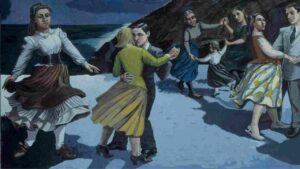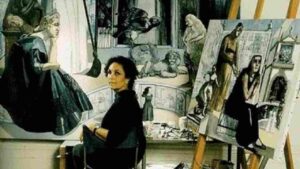B

Paula Rego was a visual artist who was born in Portugal and raised in the United Kingdom. At the age of 87, she passed away. Let’s see how did she die, what happened, and what was Paula Rego Cause of Death.
How did Paula Rego die?
Paula Rego, a world-renowned Portuguese-born British artist known for her visceral and frightening performances, died at the age of 87. Paula Rego cause of death was natural illness.
Dame Maria Paula Figueroa Rego, a Portuguese-British visual artist, was born on January 26, 1935, and was best known for her paintings and prints based on children’s stories.
Rego’s style evolved from abstract to representational, and she preferred pastels to oils for much of her career.
Her work was frequently feminized and infused with people themes from her native Portugal.
Paula Rego Cause of Death
Following a brief illness, Paula Rego died quietly.
Rego died quietly today early morning, right after a brief illness, at her residence in north London, surrounded by her loved ones, according to the Victoria Miro gallery.
It is with immense sadness that we announce the death of the Portuguese-born, British artist Dame Paula Rego at the age of 87. She died peacefully this morning, after a short illness, at home in North London, surrounded by her family. Our heartfelt thoughts are with them. pic.twitter.com/hFXdIZeTtb
— Victoria Miro (@victoriamiro) June 8, 2022
Our deepest sympathies are with them.” Paula Rego Cause of Death illness.
Paula Rego’s Early Life
Rego was born in Lisbon, Portugal, on January 26, 1935. Her father worked for the Marconi Company as an electrical engineer and was a staunch anti-fascist.
Her mother was an accomplished artist, but as a traditional Portuguese woman, she did not push her daughter to pursue a career, despite the fact that she began drawing at the age of four.
Rego’s parents abandoned her in Portugal, where she was raised by her grandmother until 1939. Rego’s grandma was to play an important role in her life.
Paula Rego’s Education
Rego was sent to Saint Julian’s School in Carcavelos, the only English-language school in Lisbon’s district at the time. St Julian’s School was Anglican, which, along with Rego’s father’s antipathy to the Catholic Church, resulted in Rego’s father’s hostility to the Catholic Church.
Rego was sent to the United Kingdom in 1951 to attend The Grove School in Sevenoaks, Kent, as a finishing school. Rego intended to begin art studies at the Chelsea School of Art in London in 1952.
He persuaded her parents that The Slade School of Fine Art was a more reputable option, and he assisted her in gaining admission. From 1952 until 1956, she was a student at the Slade School.
Paula Rego’s Career
A retrospective exhibition of Rego’s work was held in 1988 at the Calouste Gulbenkian Foundation in Lisbon and the Serpentine Gallery in London. As a result, she was selected to become the National Gallery’s first Associate Artist in 1990.
The second was Crivelli’s Garden, a series of large-scale paintings inspired by Carlo Crivelli’s works in the National Gallery and now housed in the gallery’s main café. A retrospective at Tate Liverpool in 1997, Dulwich Picture Gallery in 1998, Tate Britain in 2005, and Birmingham Museum and Art Gallery in 2007 are among the other exhibitions.

In 2007, the Museo Nacional Centro de Arte Reina Sofia in Madrid presented a significant retrospective of her work, which then traveled to the National Museum of Women in the Arts in Washington, D.C. the following year.
Rego showed at the Marlborough Chelsea in New York in 2008, and the Ecole Superieure des Beaux-Arts in Nîmes, France, hosted a retrospective of her graphic works. She had a display at Marlborough Fine Art in London in 2010 as well.
Rego appears as an interviewee in Ian McKellen’s documentary Looking for Lowry in 2011, commenting on her time at the Slade School of Fine Art alongside Lowry.

Rego employed two classic Western art tropes: “the gaze” and “the reclining nude.” She deliberately used “the gaze” to challenge the viewer, having the woman or girl look directly at the viewer, away in misery, or close her eyes in pain. The “reclining nude” emphasizes the tension that exists between sexual attraction, the act of intercourse, and the physical consequences of sex, such as pregnancy and miscarriage.
Paula Rego’s Personal Life
Rego had three children with Victor Willing, two girls (Caroline ‘Cas’ and Victoria), and a son, Nick, following many abortions that she openly publicized. Nick is a filmmaker who directed a television film on his mother, Paula Rego, Secrets & Stories, in 2017.
Ron Mueck, an Australian sculptor, was her son-in-law.
Rego was a fan of S.L. Benfica, a football club in which her family was a founding member.
Tribute to Paula Rego’s Death
Isis o’Regan said,
Paula Rego’s Abortion Series helped sway public opinion for a second referendum in Portugal which is a credit to her mastering depictions of uncomfortable realities. RIP to this provocative rebel painter
Blanca Schofield said,
I was blown away when I discovered Paula Rego’s work while studying Portuguese at university and I will never forget her retrospective at the Tate. Rest in peace to this artistic powerhouse.
Tate said,
We’re immensely saddened to hear that Dame #PaulaRego has died. Her magical, powerful, visceral paintings told stories that changed the way we see the world. This painting, featuring her son & husband, she proposed as ‘a dance of life’—of which Rego’s was extraordinary.
Rishita Nandagiri said,
Terribly sad to hear of Paula Rego’s passing- her art is so evocative and so deeply feminist. Last saw her brilliant work at the Tate last year- including her incredible (Untitled) #abortion series from 1998. The gaze is so telling. May she go well.
Grace Smart said,
KEEP READING,
How did Jim Formanek die? What happened? Cause of Death Explained
AnEsonGib vs Austin Mcbroom Who will win – Date, Tickets, Odds Analysis
Follow us on Twitter to get instant notifications and news.
News content writer.

1 thought on “How did Paula Rego die? What happened? Cause of Death Explained”